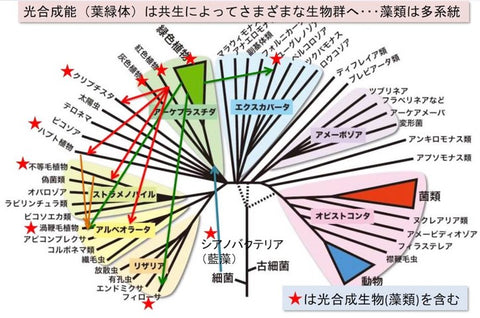``Hyakunin Kumite Solo Sumo'' is a story about what I felt while continuing the challenge of the MATSURI-related project ``Hyakunin Kumite.'' The fourth article in the series is about what the algae industry is missing.
Last time, we talked about ``looking at a map.'' This time I would like to write about the challenges faced in the industrial use of algae. Of course, there are many challenges everywhere (which is why the activity MATSURI is so meaningful), but among them is the most fundamental question for a cultural approach to algae: "Who are algae?" It's about points.

To begin with, the biological meaning of the word "algae" is not so clear. It is a general term for organisms that perform photosynthesis, excluding so-called land plants (moss, ferns, gymnosperms, angiosperms, etc.) . In other words, it is a rather strong word that does not necessarily refer to a group of closely related organisms in terms of systematics, but rather a group of species with extremely diverse characteristics. Many of the green algae (such as sea lettuce), red algae (such as seaweed) , and brown algae (seaweed and kelp) that we imagine can be found on our dinner tables, so I think they are relatively easy to imagine. However, in many cases, people tend to think of relatively large algae, and the small algae (microalgae) that MATSURI is mainly working on have only been mentioned briefly in science textbooks. I think there are many people who do.
The world of microalgae is another world of plants that cannot be seen with the naked eye. And you will feel that the world you see with your eyes is only the surface layer (in reality, land plants are life forms that have overcome aridity and have chosen to live by clinging to the thin skin of the earth). Of course, the algae that writhe in the microscopic world include green algae and red algae. If you have a slight interest in biology, you may be familiar with diatoms. Other than that, there are spell-like group names such as Alveolata , Rhysaria , and Excavata . By the way, Excavata includes Euglena, and green algae and red algae (actually, terrestrial plants as well) are subgroups of Archaeplastida . However, the types that humans can easily imagine are not representative of each group. I feel that microalgae are like the dark matter of the ecosystem.

The challenge I feel is how to communicate about dark matter . Our society still does not have an image of the microalgae group as anything more than a ``promising industrial tool.'' Of course, having such aspects is not a problem in itself, but is very important as an incentive. However, just as our society can think of various ways of thinking about the plants and animals around us, we should cultivate mature relationships rooted in human culture and be able to think about complex thoughts. Otherwise, the relationship with microalgae will be one-sided and shallow.
The grains and vegetables on the table, the cows, chickens, sheep, and pet dogs were not integrated into human life from the beginning. It is a textile that has taken a lot of effort and time to weave. And we strive to accomplish textile making in a short amount of time. I believe that the never-ending goal of building an algae industry is to be able to form rational and rich relationships with this amazingly small, diverse, and mysterious entity.
written by:Aoi Nakamura




